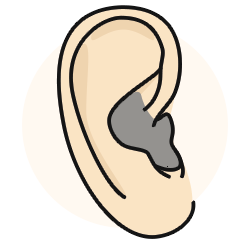What’s the difference between sensorineural and conductive hearing loss? If you have hearing loss, knowing the different types and treatments can help you made informed decisions about your hearing.
What Is Conductive Hearing Loss?
Conductive hearing loss is caused by problems with the outer or middle ear. These issues prevent sound waves from reaching the inner ear. Damage in this area might be in the ear canal, eardrum, or in the small bones in the middle ear, as a result of things like infections, bone abnormalities, foreign objects stuck in the ear, and blockage caused by earwax buildup. Children who have multiple ear infections or stick things in their ears are susceptible to conductive hearing loss.
In some cases, doctors can treat conductive hearing loss with surgery or rebuild other parts of the ear that did not develop properly. Certain medications can treat conductive hearing loss caused by infections or a buildup of inner ear fluid. Your hearing loss professional can also help with cleaning earwax buildup and let you know what you can do to prevent the problem at home to avoid a reoccurrence.
Common Causes of Conductive Hearing Loss
The blockages that cause conductive hearing loss can have a variety of origins. So if we really want to dig deeper into the causes of conductive hearing loss, we have to keep shoveling (okay, not our greatest metaphor, but you get the idea). Some common causes of conductive hearing loss include the following.
Ear Infections
One of the single most common causes of conductive hearing loss is an ear infection. This condition, particularly common among children, is pretty broad: infections can have a multitude of origins, though it’s usually bacterial in nature. Once the infection sets in, the ear canal swells (hurray for your body’s immune response). Sometimes, those ear canals swell so much that no sound can get through. The best way to treat this type of conductive hearing loss is usually to address the underlying infection, which typically requires medical attention.
Physical Obstructions
Sometimes, stuff just gets in the way. One common example is a child who ends up with a pebble or small object in their ears. Physical obstructions can cause all kinds of hearing issues–but those issues usually clear up once the foreign object (be it pebble, rock, or something else) is removed.
Colds and Allergies
Colds and allergies can wage a two-pronged attack on your ears. First, there’s your body’s typical inflammation response. Second, there’s the fluid. Colds and allergies can create a lot of fluid. And because your ears, nose, and throat are all components of one closed system, those fluids can build up in your ears, blocking already stressed ear canals.
Earwax
It’s not always pleasant to talk about, but we’d be remiss if we didn’t discuss earwax somewhere on this list. Some people simply produce more earwax than others. And when this earwax accumulates, it can hamper the ability of sounds to reach your inner ear. The problem can get worse as the earwax hardens, making standard cleaning and hygiene important.
Other Causes of Conductive Hearing Loss
In some cases, conductive hearing loss can also be caused by:
- A hole in or trauma caused to your eardrum.
- Tumors (usually benign) or other growths.
- Congenital conditions that affect the formation of the middle or outer ear.
- Fluid drainage.
The Fix for Conductive Hearing Loss
The nice thing is that conductive hearing loss can usually be treated. In most cases, your hearing can even be restored. That’s not always true for other forms of hearing loss. Talking to a hearing specialist as soon as possible after you notice any hearing loss can help you determine the best course of action in terms of corrections and treatments.
Knowing the top causes of conductive hearing loss is no substitute for a professional opinion, so always consult with your hearing specialist if your hearing suddenly–or gradually–diminishes.
What Is Sensorineural Hearing Loss?
When the nerves that control hearing of the inner ear are damaged, it can lead to sensorineural hearing loss. This is the most common type of hearing problem, and it is usually due to damage to the hair cells, or cilia, that help the inner ear carry sound signals to the brain. These hair cells do not regenerate over time, so sensorineural hearing loss due to this particular issue is usually not treatable. The good news is that people with this type of hearing problem can turn to hearing aids as a means to improve their quality of life. Loud noises, trauma to the head, diseases, aging, and hearing loss that runs in families are the most common causes of this type of hearing problem.
Some types of sensorineural hearing loss are treatable, mainly if the injury is short-term and not due to actual inner ear damage. Doctors may use corticosteroids to treat hearing loss due to loud noises that cause swelling and inflammation or for long-term treatment of autoimmune inner ear diseases that cause the body to misdirect its normal protection of the inner ear. When the damage is irreversible and hearing aids don’t do enough to improve a patient’s hearing, a hearing loss professional may recommend cochlear implants that send sounds straight to the auditory nerve and bypass the problematic inner ear.
What Are the Differences Between Sensorineural and Conductive Hearing Loss?
Sensorineural Hearing Loss Causes:
|
Conductive Hearing Loss Causes:
|
Sensorineural Hearing Loss Treatments:
|
Conductive Hearing Loss Treatments:
|
What Is Mixed Hearing Loss?
Some people have a combination of conductive and sensorineural hearing loss. This may happen, for example, if someone has age-related hearing loss, then suffers trauma to the eardrum or other outer or middle ear parts. If you have mixed hearing loss, your doctor can recommend which type is to be treated first in order to maximize your chances of success.
Is Sensorineural Hearing Loss Curable?
Let’s cut to the chase a bit: sensorineural hearing loss is not a curable condition. It’s natural to wonder if it is–to hope and wish that it might be–when you hear this diagnosis. There are treatments that can help you cope with sensorineural hearing loss and live your life in a full way, but there’s no complete cure.
Conductive hearing loss is curable in many cases; the obstruction is removed, and voila! But the causes of sensorineural hearing loss can be a bit…hairier, going well beyond a simple obstructive mass blocking the sounds.
When the tiny sound-sensing hairs in your ear, called stereocilia, suffer enough damage, they become incapable of detecting and transmitting sounds. There are no known therapies that can repair damaged stereocilia. What’s more, this damage tends to occur slowly and over time, making it difficult to spot early without making an intentional effort. But there are treatments available that can help you preserve your hearing, even if the hearing loss itself is not curable.
Will Sensorineural Hearing Loss Get Worse Over Time?
Maybe that makes it sound like sensorineural hearing loss will inevitably get worse over time. The truth about the potential deterioration of your hearing is that there are several variables at work:
- The initial cause of the damage.
- The steps taken to treat your hearing loss.
- Any steps taken to protect your hearing going forward.
- Future exposure to loud environments and damaging noises.
Sensorineural hearing loss can get worse, but it doesn’t have to. If you protect your ears and seek out the proper treatments, you can slow the degradation of your hearing and improve your quality of life.
Once damage has been detected, steps can be taken to mitigate any future damage that might occur. Sensorineural is treatable. So if you have been diagnosed with sensorineural hearing loss, getting treatment helps put you in a good position to safeguard your remaining sense of hearing.
Conductive vs. Sensorineural: Can Hearing Loss Improve?
If earwax is the culprit, once you get that earwax removed, it’s likely that your hearing will pop back up into a normal range. If you’re diagnosed with hearing loss, your first thought is probably something along the lines of: can hearing loss improve?
The good news is that most people who suffer from conductive hearing loss can look forward to improvements once the underlying issues are resolved.
So if your hearing loss is caused by an infection, or a fluid buildup, or a significant amount of earwax, treatment will improve your overall hearing ability. On the other hand, if you are diagnosed with sensorineural hearing loss, most treatment options are designed to preserve your hearing and to help you hear in spite of your hearing loss rather than improve it.
What Hearing Aid Is Best For Sensorineural Hearing Loss?
The best hearing aids for sensorineural hearing loss will typically fall into two categories:
 Behind-the-Ear (BTE) Hearing Aid: This is a hearing aid in which the bulk of the mechanics are worn around and behind the ear (almost like a pair of sports headphones). BTE hearing aids are popular with children (because the back of the hearing aid, where the bulk of the electronics are, won’t need to be replaced as the child ages) and those who suffer from severe hearing loss (because the larger case means they can pack in more powerful amplification technology).
Behind-the-Ear (BTE) Hearing Aid: This is a hearing aid in which the bulk of the mechanics are worn around and behind the ear (almost like a pair of sports headphones). BTE hearing aids are popular with children (because the back of the hearing aid, where the bulk of the electronics are, won’t need to be replaced as the child ages) and those who suffer from severe hearing loss (because the larger case means they can pack in more powerful amplification technology).
 Inside-the-Ear (ITE) Hearing Aid: Among adults who are diagnosed with minimal to moderate hearing loss, inside-the-ear hearing aids are popular because they are quite discrete. ITE hearing aids also cut down on wind noise transmitted to the wearer, which make them more reliable in outdoor settings.
Inside-the-Ear (ITE) Hearing Aid: Among adults who are diagnosed with minimal to moderate hearing loss, inside-the-ear hearing aids are popular because they are quite discrete. ITE hearing aids also cut down on wind noise transmitted to the wearer, which make them more reliable in outdoor settings.
There will be some who find little relief with either BTE or ITE hearing aids. In those cases, a cochlear implant–which bypasses the stereocilia altogether and transmits sound directly to the auditory nerve–might be the way to go.
The “best” hearing aid for someone with sensorineural hearing loss is going to be the one that most suits their individual needs, so you’ll probably want to make this decision in consultation with a trusted hearing professional.
Page medically reviewed by Kevin St. Clergy, Audiologist, on April 16, 2020.


